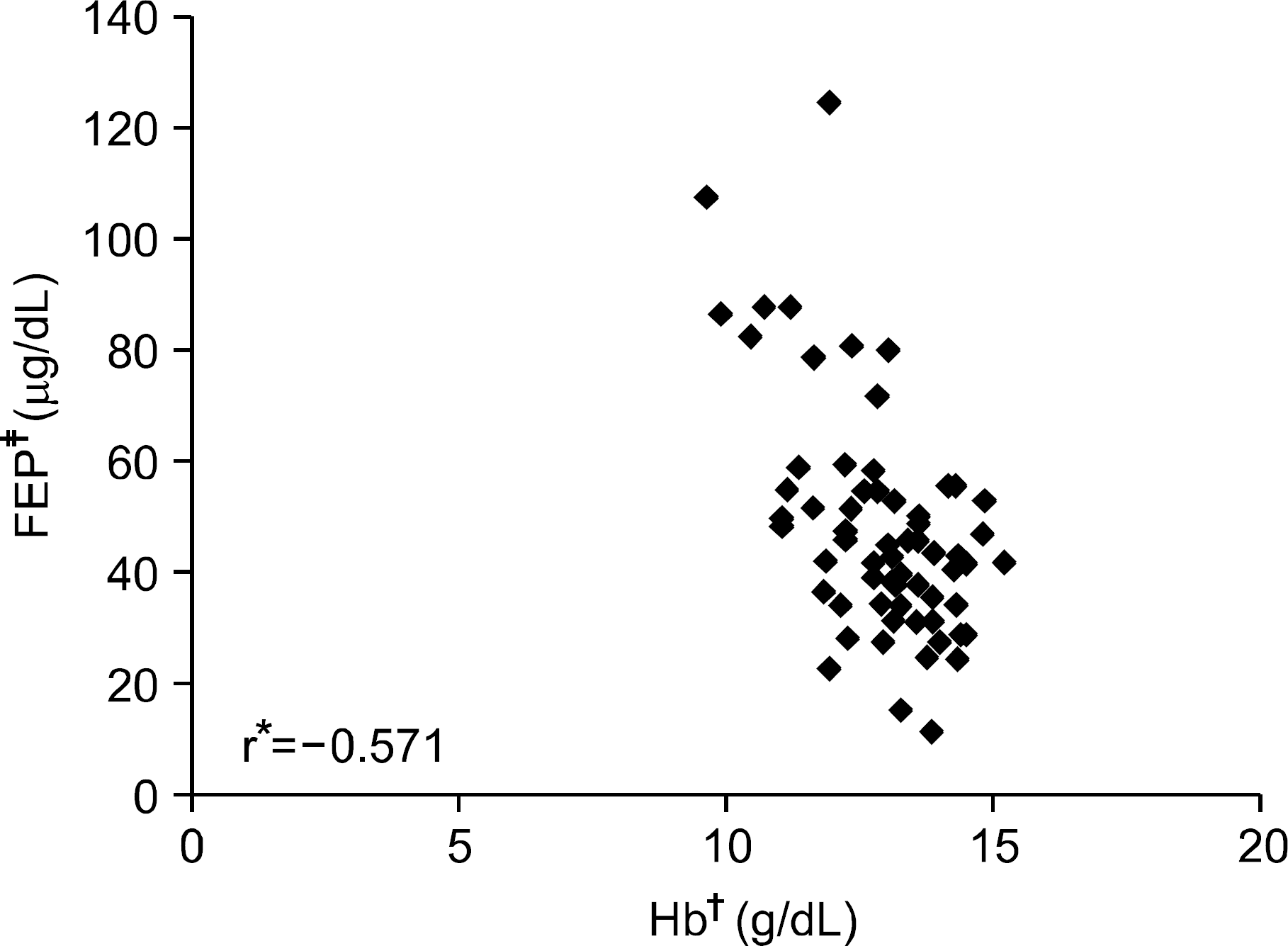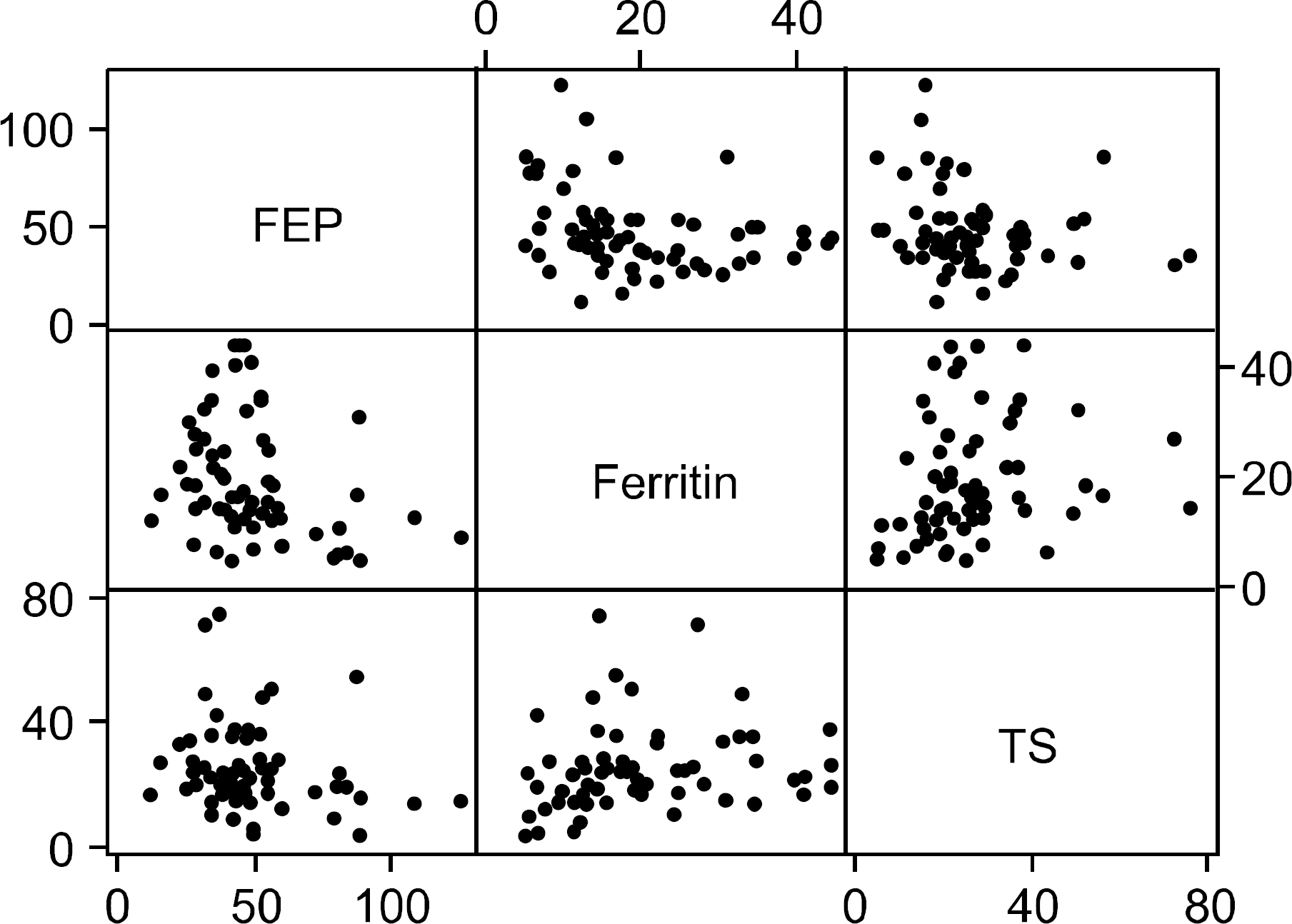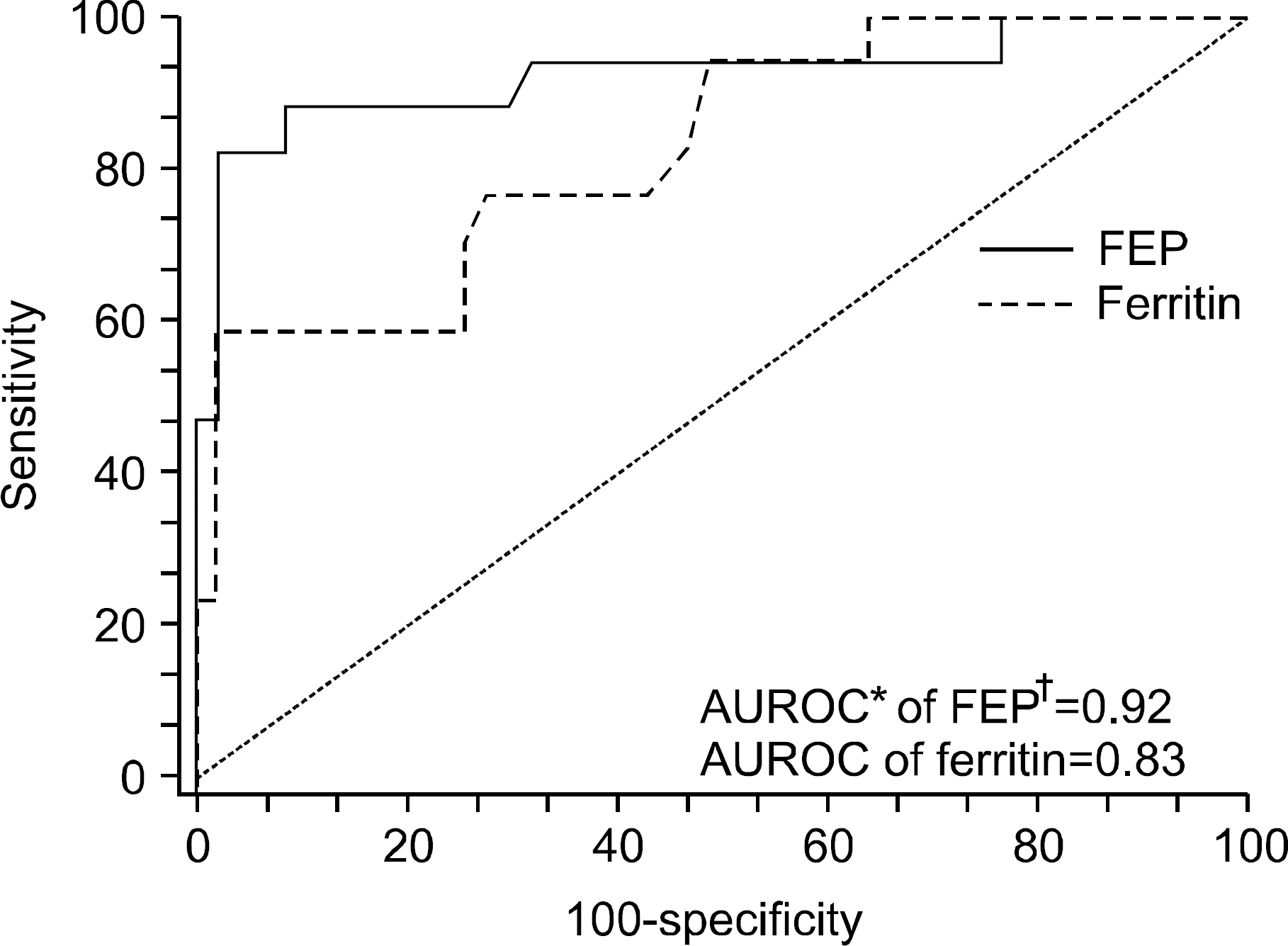Abstract
Background:
If hemoglobin (Hb) synthesis is impaired by factors other than a deficiency in free erythrocyte protoporphyrin (FEP) synthesis, the amount of FEP might be increased. In this study, we analyzed the statistical values and contribution of FEP for the monitoring and diagnosis of iron deficient anemia in adolescent female athletes according to various sports.
Methods:
We collected whole blood from 64 adolescent female athletes 13 to 19 years of age. The FEP was measured fluorometrically. After other hematological indices were evaluated, statistical analysis was performed to compare the data among various athletes.
Results:
The mean age was 14.8±1.7 (13∼19) years old. The number of runners, badminton players and shooting athletes were 46.9% (n=30), 12.5% (n=8) and 40.6% (n=26), respectively. The prevalence of anemia, iron deficiency and iron deficiency anemia were 23.4%, 23.4% and 14.0%, respectively. The measured concentration of FEP was 48.7±21.1μg/dL (12∼125). A moderately negative correlation of Hb and FEP was noted and was found to be statistically significant (r=?0.571, P<0.001). Among serum ferritin, TS and FEP, there was no statistically significant correlation. For the diagnosis of iron deficiency anemia, FEP was the most statistically significant index (P<0.001). For iron deficiency, sensitivity, specificity, positive predictive value, and negative predictive value were 88.9%, 30.4%, 33.3%, and 87.5%, respectively. The receiver operating characteristic curves, showed that FEP had excellent diagnostic power to detect iron deficiency. There was a significant difference in the prevalence of iron deficiency among the three athletes, with runners and badminton players tending to be affected more frequently with iron deficiency than static athletes such as the shooters (runners and badminton vs. shooting athletes, 33.3% and 25.0% vs. 19.2%).
Conclusion:
Our results confirmed FEP to be the most significant factor for the diagnosis of iron deficiency in athletes. Proper nutritional counseling and monitoring need to be tailored to various sports, especially in terms of static versus nonstatic sports such as runners and badminton players versus shooting athletes.
Go to : 
REFERENCES
1). Glader B. Iron deficiency anemia. Behrman RE, Kiegman RM, Jenson HB, editors. eds.Nelson textbook of pediatrics. 17th ed.Philadelphia: WB Saunders Co;2004. p. 1614–6.
2). Abrams SA. Iron requirements and iron deficiency in adolescents. UpToDate [serial online] 2005 Nov - 2007 Apr [cited 2007 Aug 27] Available from: URL:. http://www.utdol.com/utd/content/topic.do?topicKey=nutri_ch/2103&view=text#.
3). Kim SK. Iron deficiency anemia in children and adolescents. Korean J Pediatr. 2004. 47(2 Suppl):231–41.
4). Maeda M., Yamamoto M., Yamauchi K. Prevalence of anemia in Japanese adolescents: 30 years' experience in screening for anemia. Int J Hematol. 1999. 69:75–80.
6). Kim SK., Kim CS., Choi JW., Cho MH., Kim KH., Chang KJ. Iron status in adolescent female athletes. Korean J Hematol. 2003. 38:240–5.
7). Ehn L., Carlmark B., Hogland S. Iron status in athletes involved in intense physical activity. Med Sci Sports Exerc. 1980. 12:61–4.

8). Kim YK., Kang BY., Hong YJ., Son BK., Kim KH., Kim SK. Iron deficiency anemia and iron nutrition in adolescent female athletes. Korean J Pediatr. 2004. 47:1041–6.
9). Pollitt E., Hathirat P., Kotchabhakdi NJ., Missell L., Valyasevi A. Iron deficiency and educational achievement in Thailand. Am J Clin Nutr. 1989. 50(3 Suppl):687–96.

10). Idjradinata P., Pollitt E. Reversal of developmantal delays in iron-deficient anaemic infants treated with iron. Lancet. 1993. 341:1–4.
11). Bruner AB., Joffe A., Duggan AK., Casella JF., Brandt J. Randomised study of cognitive effects of iron supplementation in non-anaemic iron-deficient adolescent girls. Lancet. 1996. 348:992–6.

12). Binkin NJ., Yip R. When is anemia screening of value in detecting iron deficiency? In: Hercberg S, Galan P, Dupin H, eds. Recent knowledge on iron and folate deficiencies in the world. Paris: Colloque INSERM. 1990. 197:137–46.
13). Hijmans van den Bergh AA., Hyman AJ. Studien über porphyrin. Dtsch Med Wochenschr. 1928. 54:1492.

14). Mei Z., Parvanta I., Cogswell ME., Gunter EW., Grum-mer-Strawn LM. Erythrocyte protoporphyrin or hemoglobin: which is a better screening test for iron deficiency in children and women? Am J Clin Nutr. 2003. 77:1229–33.

15). Dallman PR., Yip R., Oski FA. Iron deficiency and related nutritional anemias. Nathan DG, Oski FA, editors. Hematology of infancy and childhood. 4th ed.Philadelphia: WB Saunders Co;1993. p. 413–50.
16). Cho JR., Kim SK., Park SK., Hah JO. Anemia and serum iron status in adolescent female. J Korean Pediatr. 2002. 45:362–9.
17). Looker AC., Dallman PR., Carroll MD., Gunter EW., Johnson CL. Prevalence of iron deficiency in the United States. JAMA. 1997. 277:973–6.

18). Nickerson HJ., Holubets MC., Weiler BR., Haas RG., Schwartz S., Ellefson ME. Causes of iron deficiency in adolescent athletes. J Pediatr. 1989. 114:657–63.

19). Selby GB., Eichner ER. Endurance swimming, intravascular hemolysis, anemia and iron depletion. new perspective on athlete's anemia. Am J Med. 1986. 81:791–4.
20). Risser WL., Lee EJ., Poindexter HB, et al. Iron deficiency in female athletes: its prevalence and impact on performance. Med Sci Sports Exerc. 1988. 20:116–21.
21). Nickerson HJ., Holubets M., Tripp AD., Pierce WE. Decreased iron stores in high school female runners. Am J Dis Child. 1985. 139:1115–9.

22). Rowland TW., Deisroth MB., Green GD., Kelleher JF. The effect of iron therapy on the exercise capacity of nonanemic iron-deficient adolescent runners. Am J Dis Child. 1988. 142:165–9.

24). Choi SJ., Choi SC., Nah YH. A study of gastrointestinal bleeding and anemia in long distance runners. Korean J Sports Med. 2001. 19:20–9.
Go to : 
 | Fig. 1Negative correlation between hemoglobin and free erythrocyte protoporphyrin. ∗ r is a Pearson correlation coefficient, P<0.001. †Hb, hemoglobin; ‡FEP, free erythrocyte protoporphyrin. |
 | Fig. 2Dot matrix plot of free erythrocyte protoporphrin, ferritin, and tranferrin saturation. |
 | Fig. 3The receiver operating characteristic (ROC) curves of free erythrocyte protoporphyrin and ferritin in adolescent female athletes with lron deficienty. ∗AUROC, the area under an receiver operating characteric curve; †FEP, free erythrocyte protoporphyrin. |
Table 1.
Age and hematologic characteristics in adolescent female athletes
| Runners (n=30) | Badminton players (n=8) | Shooting players (n=26) | P-value | |
|---|---|---|---|---|
| Age (years) | 14.9±1.7 | 16.3±2.5 | 14.4±1.0 | 0.064 |
| Hb∗ (g/dL) | 12.3±1.2 | 13.1±1.6 | 13.4±0.8 | 0.002 |
| Ferritin (ng/dL) | 18.3±10.5 | 18.6±8.8 | 21.1±1.8 | 0.061 |
| TS† (%) | 26.1±14.3 | 26.3±15.3 | 25.5±13.1 | 0.097 |
| FEP‡(μg/dL) | 54.8±25.3 | 50.8±19.4 | 41.1±12.7 | 0.048 |
Table 2.
Iron status in adolescent female athletes
| Criteria | Prevalence % (n) | |
|---|---|---|
| Anemia | Hb∗<12g/dL | 23.4 (15) |
| Iron deficiency | Ferritin<12ng/dL | 23.4 (15) |
| IDA† | 14.0 (9) | |
| NHANES III‡ | 26.6 (17) | |
| FEP§ (μg/dL) | FEP≥36μg/dL | 73.4 (47) |
Table 3.
Summary of the multiple regression model with contribution for the diagnosis of iron deficiency anemia
| Model | Unstandardized coefficients | Standardized coefficients | t | Sig. | Collinearity statistics | ||
|---|---|---|---|---|---|---|---|
| B | Sth. error | Beta | Tol.∗ | VIF† | |||
| Constant | 14.325 | 0.545 | 26.297 | 0.000 | |||
| FEP | ?0.033 | 0.007 | ?0.558 | ?4.989 | 0.000 | 0.894 | 1.118 |
| Ferritin | 0.001 | 0.013 | 0.010 | 0.088 | 0.930 | 0.902 | 1.108 |
| TS | 0.004 | 0.010 | 0.046 | 0.421 | 0.675 | 0.938 | 1.067 |
| R2=0.328 | Adjusted R2=0.294 | F=9.763 | P≒0.000 | ||||
Table 4.
NHANES III-based iron status according to the groups
| FEP | Runners (n=30) | Badminton players (n=8) | Shooting players (n=26) | |||
|---|---|---|---|---|---|---|
| ID∗ | IDA† | ID | IDA | ID | IDA | |
| n (%) | n (%) | n (%) | n (%) | n (%) | n (%) | |
| ≥36mg/dL | 9 (30.0) | 6 (20.0) | 2 (25.0) | 2 (25.0) | 4 (15.4) | 1 (3.8) |
| <36mg/dL | 1 (3.3) | 0 (0) | 0 (0) | 0 (0) | 1 (3.8) | 0 (0) |
| Total | 10 (33.3) | 6 (20.0) | 2 (25.0) | 2 (25.0) | 5 (19.2) | 1 (3.8) |




 PDF
PDF ePub
ePub Citation
Citation Print
Print


 XML Download
XML Download